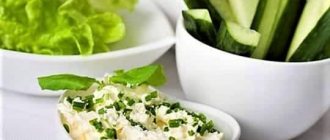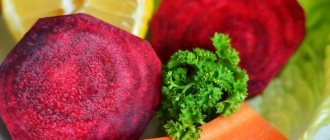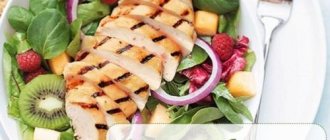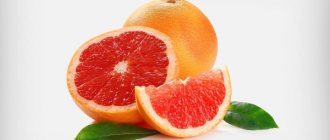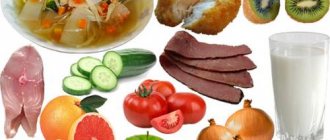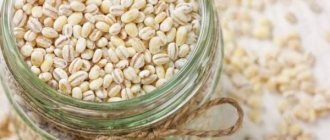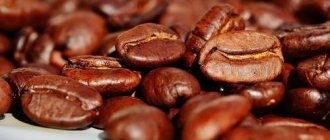The principle of the fruit and vegetable diet
The main principle of the fruit and vegetable diet is to eat only vegetables and fruits.
They can be raw, boiled, steamed, baked in the oven. Basic moments:
- The main rule is not to season them with salt and spices , and also not to add oil.
- It is allowed to eat dried fruits in small quantities - raisins, prunes, dried apples and pears, dates and dried apricots.
- Nutritionists allow consuming fruits and vegetables before bed , but not all of them, only low-calorie ones. In this case, the food should be eaten fresh; boiled and baked vegetables and fruits have a higher calorie content.
- Consuming large amounts of fluid while dieting.
- You can eat all known and available vegetables and fruits. It is recommended not to overuse vegetables with a high starch content. These include: radishes, potatoes, green peas, carrots and corn. Also, do not get carried away with high-calorie fruits: bananas, grapes, watermelons and persimmons.
There is a variety of fruit and vegetable diets in which you do not have to give up meat and fish, but in small quantities.
Peculiarities
The diet is easily tolerated by both young people and the elderly. This is due to the fact that it has weak restrictions on the number of meals and volumes of food consumed.
Peculiarities:
- This diet is short-lived; you should not stay on it for more than 7-10 days , since vegetables and fruits do not contain the animal fats and proteins necessary for the body.
- During the diet, foods with fast carbohydrates are not consumed , but foods with slow carbohydrates remain. They help break down proteins, thereby providing the body with energy.
- Complex carbohydrates contribute to long-term saturation of the body , improving overall well-being, but with a long period of their consumption.
- The diet is also suitable for people with diseases such as osteoporosis. With this disease, the body needs the daily requirement of calcium and a number of other microelements and vitamins, which helps strengthen bones.
Among the foods with slow carbohydrates are:
- dill, parsley, lettuce;
- cabbage, onions, tomatoes, bell peppers, zucchini;
- cherries, plums, oranges, apples, peaches, pears.
- blueberries, blackberries, red and black currants, sea buckthorn, strawberries and strawberries.
Is it possible to lose weight on fruits and vegetables?
Fruits and vegetables are low in calories, so the body has to use more of its own energy when digesting them than it gets from the product.
They contain plant fiber that is not digested in the body. But it creates a feeling of fullness for a long period, thereby not forcing a person to eat frequently.
Reducing the consumption of this element leads to the fact that the body is forced to spend its own accumulated energy. It is worth noting the ability of some fruits and vegetables to burn fat. Here you can highlight grapefruit, kiwi, orange, watermelon, as well as cucumber, cabbage and pumpkin.
Undigested fiber enters the intestines and, thanks to its granular structure, absorbs waste and toxins. Removes them from the body and cleanses the intestines. Vegetables and fruits increase the acidity of gastric juice, thereby stimulating its active secretion. They are distinguished by their low carbohydrate content.
All this proves that by using fruits and vegetables in the main diet, you can improve the digestion process and significantly lose weight without harm to your health.
Benefits of diet
What are the benefits of a fruit and vegetable diet:
- cleansing the intestines of waste and toxins - the digestion process is improved;
- normalization of metabolism;
- increased immunity due to the content of vitamins and microelements;
- normalization of gastric acidity;
- strengthens the walls of blood vessels, regulates cholesterol levels and helps cleanse the blood;
- normalizes blood pressure;
- improving the color and structure of the skin of the face and body, strengthening hair and nails;
- improved sleep and a feeling of lightness within the body;
- reducing a person’s weight – the load on the legs and circulatory system is reduced.
Advantages
The main advantages of a fruit and vegetable diet are:
- multiple free meal regimens, compared to other diets, are easier to tolerate by the body;
- easy to prepare, you don’t have to cook – just use the ingredients raw;
- the main thing is a tasty diet.
Flaws
The main disadvantage of the diet is that the body does not receive protein, which is involved in the construction of cells, and as a result:
- possible loss of strength and energy, poor performance;
- may cause bad mood and irritability;
- loose stools or even diarrhea may occur;
- may cause increased drowsiness.
Why is the diet popular?
The fruit and vegetable diet is popular among men and women of different ages and body constitutions. Its popularity is not accidental and is explained by the following factors:
- Allows you to lose from 4 to 8 kg. adipose tissue in 5-7 days.
- The ingredients of the diet are prepared with minimal heat treatment or eaten raw, which allows you to saturate the body with healthy, nutritious food.
- Plant foods are rich in fiber, which brings invaluable benefits to the body. It improves metabolism and the functioning of the digestive organs, helps get rid of waste and toxins. Fiber stimulates intestinal motility, is considered an excellent adsorbent and gives a feeling of fullness, quickly satisfying hunger.
- The menu is low-calorie, but rich in vitamins, minerals and microelements. It improves the calcium-sodium balance of cells, saturates them with phosphorus, zinc, magnesium, manganese, vitamins A, C, B, D, K, etc.
- No matter how many days the diet is continued, it helps not only to lose weight, but also to cope with cardiovascular problems, improve digestion and strengthen the immune system.
- It will improve the condition of hair and epithelium, strengthen nails, bones and cartilage.
- Improves and normalizes sleep, improves mood.
Rules
I would like to note a large number of rules when following a fruit and vegetable diet:
- consume about 1.5 kg of fruits per day , 300 grams per meal, for a total of 5 meals per day;
- During the day, eat more vegetables than fruits , especially in the evening, vegetables are lower in calories;
- consume more seasonal fresh vegetables and fruits ; try to ensure that the proportion of fresh unprocessed products to thermally processed products is 3:1
- , and fatty foods for the duration of the diet
- do not use mayonnaise, ketchup and oil for dressing salads ; use low-fat kefir, yogurt, lemon juice and vinegar instead;
- drink a lot of water during the day , at least 1.5-2.0 liters;
- do not use salt, pepper and sugar to add flavor to products;
- High calorie fruits are best consumed in the morning;
- use a varied menu , change it constantly during the diet;
- do not consume store-bought juices in tetra packs , sweet carbonated drinks and water;
- green fruits contain less sugar and therefore have less calories;
- add dried fruits to your diet in small quantities.
Dried fruits are great for helping the body cope with diet:
- reduce appetite;
- stimulate brain function;
- protect against stress, which is often caused by diet.
How to quickly lose weight on vegetables and fruits
Before you start limiting your daily diet, you need to analyze different methods for losing weight for individual preferences and set yourself a weight loss goal. Based on these data, you can choose a strict one-day mono-diet or a long-term balanced nutrition system. Products with a high level of protein are added to the diet: cottage cheese, dietary meat, fish, bran. A diet based on vegetables is quick and effective due to the absence of fatty foods, flour or confectionery products, sugar and dairy products in the diet.
Recommendations for choosing foods while dieting:
- green fruits have the lowest calorie content;
- vegetables are often lower in calories than fruits;
- fruits contain a large amount of carbohydrates;
- greens and herbs perfectly complement the diet and dull the feeling of hunger;
- raw vegetables are healthier;
- It is forbidden to add foods with a high fat content (milk, mayonnaise) to dishes;
- Lemon juice, yogurt or kefir (minimal fat content), olive oil are ideal for dressing;
- To lose weight and not harm your health, you need to change your diet daily.
Fasting day
A one-day mono-diet can help you lose up to 2 kg of weight. Since strict dietary restrictions are stressful for the body, it is often carried out on a day off. To unload, eat 1500 grams of one selected fruit, dividing this amount into 5 or 6 meals. You can eat foods raw or make salads, juice, smoothies. Vegetable dishes can be steamed or baked. The daily menu of the fasting day should not contain oil, salt or sugar on fruits and vegetables. Allowed to drink:
- tea (weak black, green, herbal);
- black coffee;
- water;
- compote.
- How to cook broccoli, how long?
- What to do with high cholesterol, how to treat it
- Cocktails for weight gain
Diet 3 days vegetables fruits water
A popular option for cleansing and unloading the body is a three-day vegetable and fruit diet. One of the main rules concerns drinking. You can only drink water, herbal teas, and juices. A strict drinking regime is important - half an hour before meals or forty minutes after meals. After unloading is completed, protein must be administered with extreme caution so as not to make the body feel unwell. In case of intolerance to raw food, you can carry out such a diet according to the third day menu. It is prohibited to add:
- honey;
- salt, sugar;
- dried fruits;
- sweeteners.
What is a fruit and vegetable diet for three days? Please see the table for an example menu:
| Day | Menu and recommendations |
| First (vegetable) | Fresh vegetables, salads with dressing (lemon juice or vegetable oil, 30 ml per day). It is allowed to add juices, nuts or seeds (portion up to 80 grams per day), citrus fruits (lemon). Diet: eat 5 times a day. |
| Second (fruit) | Fresh fruit (bananas are prohibited). Eat after two hours (serving up to 400 grams). It is allowed to add nuts or seeds. |
| Third (combined) | Breakfast: vegetable salad, 200 gram portion (raw beets, carrots, cabbage, zucchini) with vegetable matter. butter or nuts/seeds, oatmeal. Lunch: salad of any vegetables (serving 200 grams), stewed vegetables (serving 200 grams). You can add brown rice or buckwheat (100 gram portion), soup (broth) with these cereals. Dinner: salad with cabbage or lettuce (serving 400 grams). |
Diet products
Allowed
During the fruit and vegetable diet, it is allowed to consume any vegetables and fruits available. But you should approach this selectively and extremely carefully in order to get the desired result.
The following vegetables and fruits are considered dietary:
- cucumbers;
- tomatoes;
- cabbage;
- Bell pepper;
- beet;
- zucchini;
- green leafy vegetables;
- apples;
- plums;
- apricots;
- peaches;
- berries;
- melons;
- spinach and sorrel.
Avoid overuse and limit consumption in the following cases:
- potato;
- green pea;
- radish, radish;
- corn;
- eggplant;
- banana;
- grape;
- kiwi.
Prohibited
Forget completely about consuming during the diet:
- bread and flour products;
- alcohol;
- sugar and sweets;
- jam and jam;
- mayonnaise and dressing sauces;
- chocolate;
- pate and sausages, boiled and smoked sausages;
- fatty types of fish;
- processed cheese;
- sparkling water;
- potato chips and crackers;
- manke.
Menu for the week
We suggest considering the menu option in the table in the summer with the addition of yogurt:
| Day | Menu |
| 1 | 1 appointment – vegetable salad (cabbage, cucumber, greens) up to 300 gr. You can top it with lemon juice 2nd appointment – green apple or pear, can be cut and put in yogurt Meal 3 – vegetable soup with fried bran bread croutons 2 pcs. Meal 4 – boiled carrots and beets – 1-2 pcs. depending on size Meal 5 – boiled cauliflower, plum for dessert |
| 2 | 1 appointment – portion of baked pumpkin with apples 250 g 2nd appointment – 2-3 pcs. large plums or apricots, can be chopped and put in yogurt Meal 3 – vegetable stew of tomatoes, peppers and tomatoes 300 g Meal 4 – fresh tomatoes and cucumber, chopped and seasoned with vinegar – 250 g Method 5 – baked apples in the oven 2 pcs. |
| 3 | 1 appointment – grated carrots with apple, you can add prunes or raisins, 250 g 2nd appointment – a glass of any fruit juice with bran bread toast Meal 3 – vegetable soup with mushrooms – one serving, fruit mix Meal 4 – fried zucchini 200 g Meal 5 – vegetable salad of tomatoes, cucumbers and sweet peppers with herbs |
| 4 | 1 appointment – vegetable salad (cabbage, cucumber, greens) up to 300 gr. You can top it with lemon juice 2nd appointment – green apple or pear, can be cut and put in yogurt Meal 3 – vegetable soup with fried bran bread croutons 2 pcs. Meal 4 – boiled carrots and beets – 1-2 pcs. depending on size Meal 5 – boiled cauliflower, plum for dessert |
| 5 | 1 appointment – portion of baked pumpkin with apples 250 g 2nd appointment – 2-3 pcs. large plums or apricots, can be chopped and put in yogurt Meal 3 – vegetable stew of tomatoes, peppers and tomatoes 300 g Meal 4 – fresh tomatoes and cucumber, chopped and seasoned with vinegar – 250 g Method 5 – baked apples in the oven 2 pcs. |
| 6 | 1 appointment – grated carrots with apple, you can add prunes or raisins, 250 g 2nd appointment – a glass of any fruit juice with bran bread toast Meal 3 – vegetable soup with mushrooms – one serving, fruit mix Meal 4 – fried zucchini 200 g Meal 5 – vegetable salad of tomatoes, cucumbers and sweet peppers with herbs |
| 7 | 1 appointment – fruit salad with yogurt total weight up to 300 g 2nd appointment – fresh radishes with tomatoes, you can chop everything and season with vinegar Meal 3 – stewed zucchini with tomatoes and peppers 300 g Meal 4 – cherry-apple puree from fresh fruits 250 g Meal 5 – boiled cauliflower and fruit jelly |
Diet option for the week
| Breakfast | Fruit salad or fruit with low-fat sour cream, or low-fat cottage cheese with dried apricots, prunes and raisins. |
| Dinner | Rice with stewed vegetables or pasta, as an alternative - a hard-boiled egg and fruit and vegetable salad. If you feel hungry, you are allowed to have a snack or juice, drink a cup of unsweetened green tea or a milkshake with fruit. |
| Afternoon snack | Fresh juice or fruit, if you feel hungry, you can drink a cup of green tea with a slice of black or bran bread. |
| Dinner | Lean boiled or baked fish, which is complemented with vegetable salad with olive or other vegetable oil. Before going to bed, you can drink a glass of fermented milk drink, eat an apple or grapefruit. |
The fruit and vegetable nutrition system is most useful if you prepare juices at home rather than buy them in the store. Freshly prepared juices contain a maximum of vitamins and will bring great benefits. If you decide to go on a diet during the cold season, you should additionally introduce complex vitamins in tablets into your diet.
Other Diet Options
Protein-vegetable fruit
This is a symbiosis of protein-vegetable and fruit-vegetable diet. It combines alternating vegetables and fruits with protein foods. The best fruits to consume are green apples, citrus fruits, plums and berries.
You can consume these products raw, or you can squeeze fresh juice out of them, grind them into puree or cut salad. It will be very tasty to top it all with low-fat yogurt. Eat significantly more vegetables than fruits. Consume fruits in the morning.
This is a very varied and not strict diet; the number of allowed foods here is increased compared to fruits and vegetables. Lean dietary meat is allowed to be consumed, so it is easily suitable for meat lovers.
The diet is easily tolerated for 3 weeks, and this is its main difference from the fruit and vegetable diet. Avoid eating meat three to four hours before bedtime.
What can you eat with fruits and vegetables on a diet:
- eggs;
- lean meat and fish;
- seafood;
- low-fat kefir and yogurt;
- mushrooms.
We adhere to the rule that food cannot be fried, only boiled, stewed and baked without salt and spices. The remaining rules are the same as the previous fruit and vegetable diet.
Fruits and vegetables + meat
This diet is a subtype of the previous diet and its peculiarity is that every day you need to eat vegetables with a small amount of meat (pork, chicken or turkey). And as a dessert - some delicious fruits.
The meat is consumed thermally processed; try not to fry it. Vegetables are eaten raw, but they can be boiled or baked.
It is recommended to alternate protein days with carbohydrate days. Thus, supplying the body with useful vitamins and microelements and preventing a decrease in muscle mass, which often occurs during other diets.
During this diet, it is recommended to eat dietary meat, preferably chicken breasts or turkey meat. Dietary meat includes not only poultry, but also animals - veal or rabbit.
What to eat:
- daily – 200 grams of meat;
- vegetables – 400 grams;
- porridge, except semolina – 200 grams;
- unsweetened green fruits - 3-4 pieces.
Alcoholic drinks and sweets are strictly prohibited. For other rules and advice, you should refer to the general fruit and vegetable diet.
Fruit and vegetable + kefir
The diet is suitable for lovers of fermented milk products; it is not strict. Using low-fat milk you can prepare cocktails, yoghurts and kefir. Combine vegetables with fermented milk dressings.
It will be very tasty if you add ground fresh fruits and berries to low-fat cottage cheese; also add them to other dairy products. It is allowed to diversify vegetable dishes - stew, squash casserole or vegetable soup.
The menu is very varied with milkshakes with frozen or fresh fruits and berries. With this diet, you are allowed to drink: tea and coffee, various fruit compotes - without sugar, as well as freshly squeezed juices.
The main components of the kefir diet:
- raw vegetables, vegetable soups, salads and sautés;
- kefir, yogurt and various variations of dressings and sauces based on them;
- skim cheese;
- low-fat milk and milkshakes;
- raw fruits.
Fruit and vegetable + porridge
Porridges are considered a storehouse of nutrients and minerals; they contain complex carbohydrates, vegetable proteins and fiber. In order to properly enter the diet, it is recommended to give up fatty foods and sweet desserts 5-6 days before.
It is better to choose coarsely ground cereals for food - not fried or polished, since the shell of the grains stores the largest amount of valuable substances. Before cooking, the cereal must be thoroughly rinsed with water.
It is recommended to keep the grains in water for several hours for quick further cooking. The less the porridge has been subjected to heat treatment, the more valuable it is.
The following are prohibited on this diet:
- bread and products made from it;
- meat and its by-products;
- fish;
- sausage and frankfurters;
- potato;
- chocolate, sugar and sweets;
- milk, butter and other milk products;
The diet is based on the action of fiber, which enters the stomach and ensures long-term satiety. And passing further into the intestines, it cleanses it of toxins and waste. According to the general rules and requirements for fruits and vegetables, everything remains the same as in previous diets.
Full day unloading option
A fasting day involves eating throughout the whole day a small amount of the same type of food that is easily digested in the body. As a rule, a person chooses one or two products, less often several.
It is better to unload the body the next day after noisy holidays and anniversaries with large feasts, when the stomachs and liver need to be given a “day off”.
What benefits can be noted from fasting days:
- removes toxins from the body;
- provides the digestive system with a break from the hard work of digesting food;
- strengthens willpower;
- helps weight loss when it slows down, spurring this process.
Fasting days are best done once a week. But to achieve the planned result, one day is not enough; in the remaining six days you need to adjust your menu.
On buckwheat and kefir
It is very difficult to eat just kefir all day, so a good combination when unloading would be with buckwheat porridge. The porridge should be prepared correctly in the evening - pour 250 grams of washed cereal with boiling water, cover with a lid and leave until the morning.
To steam it, it is better to place it in a warm place or wrap it in a blanket. The entire portion should be divided into five parts according to the number of meals.
You can add fruits and vegetables in small quantities to the porridge. It’s worth stocking up on 0.5 liters of low-fat kefir for the whole day. In addition to water, tea and coffee without sugar and milk are also allowed. The combination of kefir and buckwheat can cause a laxative effect.
Fruit and vegetable menu options
Let's start with a diet designed for one day, the reviews of which are very positive. It is useful for those who have problems with digestion and the gastrointestinal tract, who do not want to lose weight, but to give the body rest and improve overall well-being.
- The day is spent on green food, filling it with dishes of fresh fruits and vegetables.
- It is advisable to limit or eliminate salt, sugar and spices as much as possible.
- If you want something sweet during the day, eat a handful of raisins or a sweet apple.
- Avoid mineral water and carbonated drinks, replacing them with jelly and juices, fruit drinks and compotes.
Contraindications
Fasting days have a limitation:
- For pregnant and lactating women. In this case, they should consult a doctor for advice.
- This rule also applies to people with chronic diseases.
- It is worth forgetting about fasting days during colds and flu, as well as in the postoperative period, when the body is weakened and needs food to maintain strength.
- People with stomach ulcers should be very careful about their diet, in which the consumption of raw vegetables and fruits is limited.
Recommendations
For weight loss to be effective and for long-term results, you need to know and adhere to the following rules:
- maintain physical activity , play sports, go for walks both during the diet and after it ends;
- be patient , especially in the first days of the diet;
- after finishing the diet, adjust your menu , reduce portion sizes, give up fatty and high-calorie foods;
- eat more fruits and vegetables;
- drink less mineral water, juices in tetra packs, tea and coffee , rely on clean water;
- give up alcohol;
- leave five meals a day , eat high-calorie foods in the first half of the day;
- in the evening, try to reduce your portion sizes;
- Replace pasta and bread with vegetables and fruits.
The first day of an effective diet for a week is fruity
On the first day of the diet, you can eat any fruit except bananas. In this case, preference should be given to watermelon, apple, pomegranate and any citrus fruit.
Of all the citrus fruits, nutritionists recognize grapefruit as the best for weight loss. It contains a small amount of sugar and a lot of fiber, which improves digestion. Bitter varieties of grapefruit are considered the best.
For a very effective diet, apples should be chosen small ones. They contain more pectin, which promotes the formation of mucous substances in the intestines that stimulate bowel movements. Phosphorus and potassium contained in apples have a beneficial effect on the kidneys.
There are no restrictions on the amount of fruit eaten on the first day of an effective diet for a week, but they cannot be consumed in the form of juice. To achieve the effect, it is considered optimal to eat 4 apples, 4 oranges or grapefruit, watermelon and 2 pomegranates per day.
How to get out of a diet correctly?
No less important information than about the diet itself is how to get out of it correctly so as not to regain lost weight and not harm your health.
There are general rules for quitting a diet:
- new foods must be introduced into the diet gradually in small portions;
- do not reduce the amount of fruits and vegetables in your diet; switch to eating them raw, unprocessed;
- the amount of calories consumed from fats and carbohydrates increases gradually by 150-200 kcal per day;
- the period for leaving the diet is 7-12 days, depending on the type and severity of the diet;
- do not eat fatty or high-calorie foods at least three hours before bedtime;
- The longer the diet lasted, the longer it took to come out of it.
Protein-vegetable fruit diet
Thanks to the addition of protein-containing foods, the nutritional system becomes more balanced and long-lasting (from 14 days to a month). Nuts, seeds, cereal flakes, flax seeds, and sesame are added to the daily menu. Protein products are administered in a standardized manner:
- fish – 150 grams per day, twice a week;
- cottage cheese – up to 100 grams per day, 4 days a week.
A balanced diet of 1200 calories for a week involves heat treatment of some foods, although only a few cooking methods are allowed:
- boiling;
- steamed;
- baking.
Reviews
We bring to your attention several reviews of people who were able to lose weight thanks to a diet of fruits and vegetables:
Alexandrova Anastasia
Nutrition and healthy lifestyle specialist and author of myfitnesblog.com. For many years, she has successfully helped women and men lose weight and maintain a beautiful figure.
